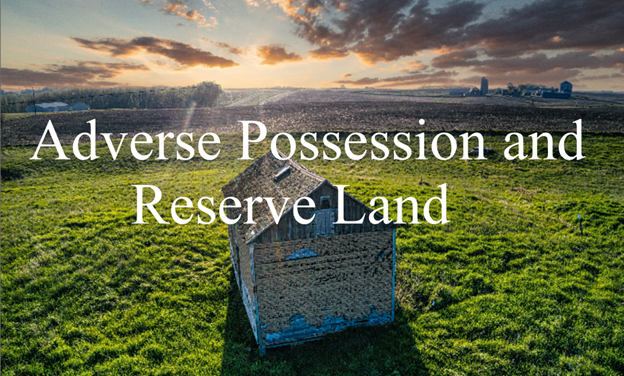First Nations with reserves administered under the Indian Act or a land code and those who hold possessory interests in such reserves should be aware of the potential application and impact of adverse possession on reserve land.
We recently researched the issue of whether a band member could claim another band member’s allotted land within a reserve on the basis of exclusive possession. While it is well established that adverse possession does not apply to common land, it appears that a member’s allotted interest in reserve land could be impacted by adverse possession by another member.
The Law of Adverse Possession
Under the English common law, an owner of land has the right to recover possession from an unauthorised occupant through a legal action known as ejectment. However, if the lawful owner fails to take action to recover the land for a sufficiently long period of time, the courts may refuse to grant an ejectment order where it would be inequitable to do so. This is the principle of adverse possession which remains applicable in certain, but not all, parts of Canada.1
The legal right of the occupant under adverse possession is a shield against removal — it is not title. The occupant does not have the rights of an owner, but merely the right to continue in occupation. However, provincial legislatures in the provinces in which adverse possession has not been expressly repealed by legislation have enacted limitations statutes that prescribe the minimum length of the period of continuous occupation for the defence of adverse possession to apply, and legislation which enables the occupant to convert protection from ejectment into actual title to the occupied land.
Does adverse possession apply to common band land or to certificates of possession?
Section 20 of the Indian Act seems to exclude the creation of any interest in reserve land by mere occupation:
Possession of lands in a reserve
20 (1) No Indian is lawfully in possession of land in a reserve unless, with the approval of the Minister, possession of the land has been allotted to him by the council of the band.
In the case of common band land, the courts have upheld that interpretation of subsection 20(1)2 but there are some important exceptions.
Some bands in western Canada allot lands to members under inherent jurisdiction instead of under the Indian Act and do not remit the allotments to the Minister for approval. A lower court in Alberta has recognized that, for those bands, an allotment by band council creates an enforceable possessory interest in common band land which may be recognized despite the lack of a certificate of possession or the Minister’s approval.3 Allotment without the Minister’s approval is also recognized in the case of First Nations which adopt a land code pursuant to the Framework Agreement on First Nation Land Management.
A third exception arises in the administration of estates under the Indian Act. Section 12 of the Indian Estate Regulations provides that the Minister has authority to presume that “a transfer of possession has taken place” where a deceased Indian occupied land without a certificate of possession for a continuous and uninterrupted period of 30 years, and may issue a certificate notwithstanding the fact that there is no evidence of a band council allotment:
12 (1) Where the deceased Indian had been in peaceable, public and useful possession of land on a reserve for a continuous and uninterrupted period of 30 years, transfer of possession may, at the discretion of the Minister, be presumed to have taken place and in such event the onus of proving that prescription did not run or of disproving the transfer shall be upon any person claiming adverse possession.
Subsection 12(1) also expressly states that another member may dispute the presumed transfer by proving prescription4 or adverse possession of the land which the deceased is alleged to have exclusively occupied. This seems to make it clear that the common law applies to reserve land in certain instances, and that the appropriate time frame for recognition — by the Minister, at least — is 30 years.
However, in Bradfield v. Canada (Indigenous and Northern Affairs)5 decided in 2018, the Federal Court accepted the Minister’s interpretation that section 12 of the Regulations does not apply to common band land, since otherwise it would be in conflict with section 20 of the Indian Act. The decision restricts the scope of section 12 of the Regulations and the principle of adverse possession to allotted reserve land.6
Summary and Conclusions
For reserve land administered under the Indian Act7, adverse possession is inapplicable to common band land. However, a claim by a member based on occupation of land lawfully allotted to another member, where that occupation has been open, notorious and continuous and has deprived the lawful owner of the use of the land for thirty years, is capable of recognition by the Minister. There is no reported decision on whether the Minister can be required to recognize a claim by a member with respect to land allotted to another based on adverse possession, but that is the only scope remaining to section 12 of the Indian Estate Regulations and would be consistent with the decision in Bradfield.
Members of our Indigenous Practice Group at Fogler Rubinoff LLP would be pleased to discuss how this conclusion may impact the management of a First Nation’s reserve land or an individual member’s possessory interests claims.
_________________________________________________________
[1] For example, adverse possession was abolished in Alberta by the Property Rights Statutes Amendment Act, 2022, SA 2022, c 23. Adverse possession applies in Ontario to titles registered in the Land Registry system but not to titles in the Land Titles system. Beginning in 1999, Ontario has administratively converted almost all titles in the province to the Land Titles system, but possessory rights acquired before a title was administratively converted may still be capable of proof.
[2] Courts have consistently followed Joe v. Findlay (1981), 122 D.L.R. (3d) 377 (B.C. C.A.
[3] Many Guns v Siksika Nation Tribal Administration, 2003 ABPC 164).
[4] Prescription is an alternate term for title acquired by use and passage of time, used in Ontario primarily in the case of rights of way.
[5] 2018 FC 682, at para 51: “The Minister’s determination that section 12 of the Regulations does not permit the issuance of a Certificate of Possession for land that has not already been allotted … pursuant to section 20 of the Indian Act is reasonable…” (emphasis added).
[6] Since Bradfield dealt with common land, this aspect of the reasons in the decision was not technically before the court. To date, s. 12 of the Indian Estate Regulations has not been judicially considered in the context of allotted reserve land.
[7] Whether adverse possession is permitted or abolished with respect to a reserve governed by a First Nation land code depends on the interpretation of the individual code.
This publication is intended for general information purposes only and should not be relied upon as legal advice.












